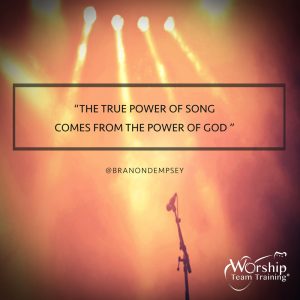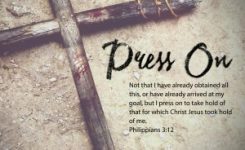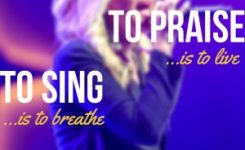Leaders, Songwriting, Worship Leading
The Power Of Song (Show #49)
 #ClosenessOfGod
#ClosenessOfGod
4.5 min read
What is the song?
A short poem or other set of words set to music or meant to be sung. Song and music are gifts from God. It means something to you, otherwise this post would not be of interest.As a musician, singer, songwriter and/or worship leader, God blessed you with the gift to create music and to produce songs.
How useless would it be to receive such an awesome gift, but it remains unopened, unused and undeveloped.
What is the power?
If we can sing and play all the notes of a song, but do not have love in our hearts, then we are just a clanging cymbal. The same is true of our music, without the love of Christ, our song is just noise (Ref. 1Cor. 13.1, Amos 5.2.) The three basic necessities of music is melody, harmony and rhythm.
This is reflective of having the spiritual needs of being a child of the Kingdom: The Father, Son and Holy Spirit. When Life in the believer springs up from the heart, it is the unmistakeable sound of salvation. This is incredibly beautiful and meaningful when our music becomes one with God.
When we apply worship, there is a marvelous and spectacular power that comes from song. The question is: how are we tapping into this power to be used by God, all to bring others and ourselves closer to Him?
How does God use the power of song?
A different perspective takes place when we offer ourselves to be used as His instrument. No longer can we keep our gift from God or others. We begin to be generous in the sharing of our gift. Also, we are moved to nurture our skill, craft and production of music. The Holy Spirit is the one working through us to create song and He sings and plays it in accordance to the Gospel – glorifying the Father as it also reaches and ministers to people. The study of song is just as important as the making of music. When we learn how to put notes and lyrics to work, we receive wisdom from God to help further our development. In-turn, this benefits those who hear it: the worshiper, the Church and the lost.
What is the break-down of the song?
Let’s begin to understand the building blocks of song. There are two basic musical activities found in any form of music: repetition and change. This is also referred to as development, providing similarity and contrast found in the given piece of music. Also, we see open and closed musical phrases that complete a full functioning section. In other words, you would have a beginning, which would build a music phrase and tension, and an end, which serves as its conclusion or resolve of the section. Song is divided into sub-components or sections, such as: Verse, Chorus, Bridge, etc. Each of these sections are built on what we call the basic big three: melody, rhythm, harmony. Each song section will display varying parts of repetition and change, that is tied together through the piece of music. We also we the beginning, build and resolution of the big three. We also hear the tonality, length of phrases, rhythmic passages, melodic shape (vocal or melody line), as well as the key and range of the song.
Song Forms: Most popular songs are generally 3-4 minutes in length. Form refers to how the song sections are arranged in a particular order: Verse, Chorus, Verse, Chorus, etc. (A / B / A / B ). There are multiple song forms that writers use, all are dependent upon taste and musical choice that serves the song. (i.e.: AA / BB; AA / B / A). Forms are used to help develop contrast and repetition in song to maintain and expand the musical idea or lyrical thought. The true power of song, comes from the power of God as we sing our prayers.
Intro: This musical section is the beginning of the song that maybe states the opening melody, rhythm or chords. As you would find in a book, the intro gives the setting, context, theme, mood, tone, and maybe the introduction of the story’s characters. The intro gives the listener the melodic or lyrical idea.
This section may reveal a short version of the melody or hook of the chorus, heard by vocal or instrument part. Usually it’s brief and is played once at the top of the song, and maybe used as an instrumental point between Chorus and Verse or Bridge sections.
Verses: This section spins out the lyrical story and furthers the action. The verse is composed by a series of lines, meter and rhyme scheme of the lyric. Once the verse is stated, it usually remains unchanged in form, as the song moves through the Chorus and back into Verse 2. The dynamic is generally low, so the lyrical melody pops-out. The verse can be carried by a single voice, guitar, bass and simple drum part.
The point is to have the band serve the singer. It’s a rolling out the carpet – if you will – to make way for the message of the song. The verse serves as the story telling portion of the song. Like the intro, it provides the context and build-up for the main central theme found in the Chorus. Generally, the melody displays tonal changes, shape and range, as well as rhythmic action to give the song character. It tells the “what” and “how” the story goes.
PreChorus: Not every song contains this section, but it serves as a middle build-up towards the next section. It functions like a mini bridge to display contrast in the melody and lyric, as it sets-up the punch of the chorus.
Chorus: This is the main central statement of the song. It is the author’s main point of the story and lyric. The melody is usually simple, repetitive and contrasting from the verse. It is the “Why” of the song – the main point. The vocals and instrumental parts are raised a bit in volume and action. The musical energy is higher than the verse to help propel the meaning of the song.
The melodic range maybe higher to show more contrast and color to emphasize the lyrical “hook.” Churches typically sing more on the Chorus sections due to the easy lyrics and simple melody. This is the most memorable part of the song. It’s simple to follow and fun to sing. If you think of any favorite song right now, you’ll most likely be reminded of the chorus. This is the same thought process of the church as they recall songs to mind.
Bridge: This section serves as the connection between the verses and chorus. The purpose is to help unify the lyrical theme, hence the name “bridge.” There are other uses for the bridge, it may involve a melodic contrast, drum break-down, modulation or other musical ideas.
In in the end, the purpose is to help point the listener/worshiper back towards the final hook. Usually, the musical development in the band or voices will build back up to a climax and release into the familiar melody of the chorus.
Last/Final Chorus: This is the final push of the song. Here, the chorus is loud and proud to display all the previous song elements, coming together in one big grand finale. The vocals are strong and dynamically louder, including the band. The point here is to re-highlight the grand theme of the song.
Who it is about, what it is and why it is important to sing. In the application of church/worship music, the chorus is the major meditative lyric or prayer we sing to God. It is indeed a prayer, as the chorus rings out from the soul. A message of declaration and affirmation of our love, devotion and praise to God.
Ending/Turn Around/Vamp: This section is found at the ending of the song. It is the last few lines that point back to the song’s message. This can be sung again from the chorus or even verse. This section pivots, or turns-around to repeat the final last words of the song to draw emphasis.
Also, the section can be a continuation of the final chorus – big and grand; or it can dovetail softly back into a lower dynamic, in reflection of the opening of the song. The idea is to echo the song’s major theme and to give final conclusion and thought. For the worshiper, it is to help serve another point of meditation in their prayers to God.
“Our number one job as a worship team is to help the Church worship.” @BranonDempsey
Does your church sing…No, do they really sing?
In church worship, unless the song is a well-known hymn or familiar contemporary tune, most churches typically do not sing on the verse. Due to the number of lines, words, syllables and rhythms, or melody for that matter, people will simply try to follow by ear. This is not always the case. If it is a new song, people are not familiar with the melody. However, once they hear it the first time, they are more likely to sing the words as the music moves back to the second verse. Again, if the church knows the song or hymn well, they may sing the entire tune.
On the Chorus, the melody is also usually in a different range from the verse. It can start from the same “home” note found in the verse, all the way to a third, fifth or even octave above. Most trending contemporary music of today places the opening chorus note or range between a fifth or full octave above the home note (verse). One of the reasons is to promote energy and dynamic in the song. It is a great effect to use, but the caution is to use it wisely where you do not lose the church.
In other words, if the chorus section is too high for the church to sing, they will stop singing. The song will suffer a power outage, as people will not be able to follow. What makes songs powerful for worship is when everyone (or most) are engaging to sing the song.
The music is not as dependent on the band; it’s also interdependent on the people to sing, while at the same time, a strong leader to help facilitate the song.
The Recap
Churches like simple. They are not made up of musicians and professional singers. Your church is made up of plumbers, stay-at-home moms or dads, company engineers, retirees and students. The most musical exposure they may get is by radio, internet and social media. The difference is they do not play or sing as skillful as a band/vocal team member. Our job as a team and as worship leaders, is to help put the song in the hands of the people so the may sing.
Even more so our number one job as a worship team is to help the Church worship. Music, song and worship (likened to our relationship with God) is a three-folded cord that is not easily broken (Ref. Eccl 4.12). Worship is a response to God; music and song is an expression of our worship.
Without the beauty of melody, the richness of harmony and the synergy of rhythm, music and song would be lifeless and powerless. The better you can give shape to the song, the better you will help worshipers engage in song.
@BranonDempsey @worshiptt
WATCH SHOW #49!
How can your worship team benefit from learning new vocals techniques, creative ideas for your band and be inspired to transform your ministry into worship unity? Get motivated.
Get a custom WeekendWorkshop that comes to you!
Copyright 2016 Worship Team Training®









